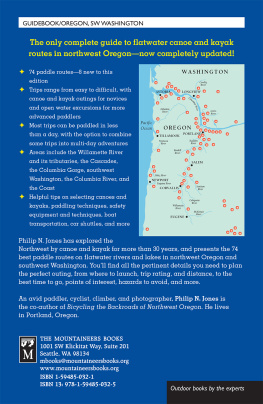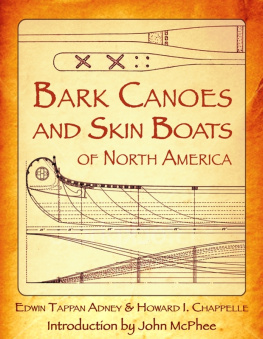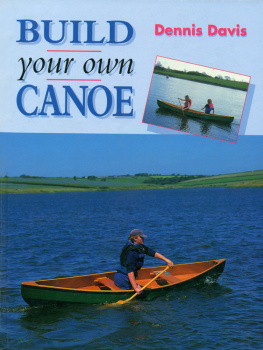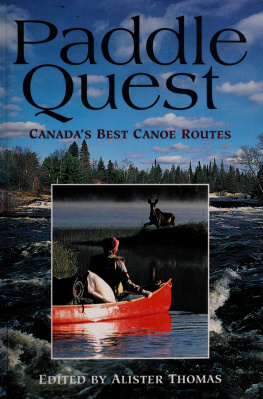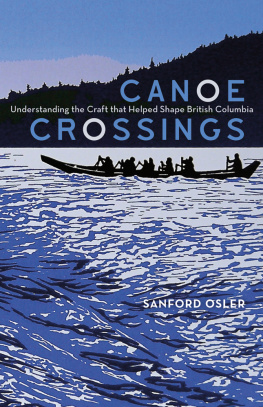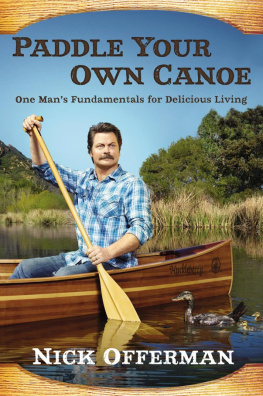BARK, SKIN
AND CEDAR
E XPLORING THE C ANOE
IN C ANADIAN E XPERIENCE

J AMES R AFFAN

To Gail Cole Simmons
navigator, teacher,
partner
A T A FANCY DINNER IN OTTAWA not so long ago, I happened to sit next to woman from Montreal who, in the polite chatter over preprandial drinks, learned that I was writing a book about canoes. With that, she told me a story about a Danish friend of hers who was mad about birchbark canoes. This chap had studied canoes from his Scandinavian home, he had corresponded with paddlers around the world, he had plied interest into obsession, found his way to Canada and actually purchased a bark canoe to take home. One day the doorbell rang, my dinner mate explained with a twinkle in her eye, and there was Sven [well call him Sven] at the door with a birchbark canoe under his arm. I hadnt seen him in years, and we had a great visit, but I wasnt so fussy about having to store his birchbark canoe in my living room for weeks until he could figure out a way to ship it home.
Canada, it seems, has an interminable supply of such tales. Travel by train from Kingston to Toronto, turn to the end of the car and one sees an artfully rendered poster of blue lake and rocky shore joined by empty canoe with paddle akimbo, as if waiting for a weary traveller to pick it up and take an imaginary voyage into the wilderness fantasy that is Canada. Look out the window, passing through Napanee, Belleville, Trenton, Cobourg, and even Toronto, and between the rusted backsides of industry there are backyards and porches, and many a faded canoe awaiting the next family venture. Talk to the porter, the conductor, ones seatmate and there are canoe stories of one kind or another. Open the VIA Rail magazine and see an ad for CANOE (Canadian On-Line Explore) an Internet service provider. Look up to the ceiling and see tiles painted sky blue with fluffs of white, more hints of the great beyond as it might have looked to the explorers themselves.
At one end of the spectrum, canoes are clich, theyre everywhere. At the other extreme, canoes are invisible, theyre everywhere. Like the railway, the mountains or Hudson Bay, theyre part of who we are, an immutable fact of Canadian life. But if one were to pick up any canoe in any part of Canada, hold it up to the light, turn it lovingly over and admire its curves and imperfections, ask of its experiences on the waters nearby, stories will flow, stories that speak something of the essence of its paddlers and the place it calls home. These stories, many of them known only to the people who built or paddled the craft, deserve to be told to a wider audience, because they sum to a generative tracing of a northern nation. And that is more or less what I set out to do in this book.
A year into the writing, however, I made the mistake of attending a dance with a voyageur theme, and therein lies a canoe story to get things under way. It sounded harmless enough, and a decidedly Canadian thing to do, a dance with a voyageur theme. The band for the costumed occasion was called Rubaboo, after pemmican soup, and included a line-up of musicians who, in their real lives, were about as close to modern-day voyageurs as one could get. There was Peter Labor, who runs an outfitting and tour firm on Lake Superior; Jeremy Ward, a birchbark-canoe builder; and a third troubador who, by association with the other two and in his ceinture flche, was voyageur enough for me. With my spouse, Gail, dressed in the fine tradition of marriage la faon du pays, and me in an assemblage of raw cotton and buckskin, we headed for the dance floor. Things were going splendidly until midway through the first jig, when my left Achilles tendon broke with a unappetizing snap.
In those first moments of shock and disbelief, while the pain took a moment to register, my main concern was that some keen paramedic would cut off my prized deerhide pants with those penny-cutting shears they all carry. A quick trip to the washroom saw to it that the trousers were replaced with a pair of shorts. Off we trundled to Kingston General Hospital emergency department, where heads turned in bemused disbelief to see a wounded voyageur arrive, in Bermuda shorts and buckskin, draped like a third lumpy braid on his colourful country wife.
In due course, the tendon was stitched back together, a full leg cast applied, and I was shipped home with a packet of painkillers and a twenty-seventh-generation photocopy of instructions on the proper use of crutches. Through analgesic haze over the next few days, lessons from the incident started to register: (a) helplessness is frustrating; (b) frustration accomplishes nothing; (c) it is difficult to perch at a word processor with a bent leg cast extending from crotch to the tip of outstretched toes; (d) it is impossible to do anything with an attention span of thirty seconds; and (e) casts and canoes are not supposed to be mixed. No canoeing. No canoeing!
With the help of my willing partner, who had some sense of how devastating was this last realization, we tried anyway. Getting into the canoe was a trick, but we managed. Paddling, by comparison, was a restorative breeze, as long as one did not dwell unduly on the prospect of swimming in the event of upset. But we canoed on the sparkling waters of Cranberry Lake and all was right with the world.
Encouraged by the success of this outing, I started getting around our split-level home on the crutches with some facility until, a day or so later, I lost concentration and fell down six stairs, fracturing my left arm. The problem with falling down stairs with crutches, one learns, is that they act as a movable fulcrum that in effect launches a person into a high arc before gravity prevails and the floor rushes up with crunching velocity. At that point, I had to concede, canoeing was definitely off the agenda.
It was the sudden loss of freedom that was most disconcerting. I had no idea the extent to which canoeing defined me, and the gratuitous way in which I had taken this mobility for granted. Thinking back on the many days in my workaday life, prior to these accidents, I saw how deeply satisfying it had been to know that I could canoe, if the spirit moved, even if I chose not to canoe. But, for a while, that possibility was gone. Canoeing was out. And I felt claustrophobia that was even more constricting than the plaster casts. Ruptured, if only for twelve weeks, was the sustaining, if utterly romantic, notion that I could get in a canoe outside the back door and paddle to Lachine or Moose Jaw or Tuktoyaktuk. It was a difficult time, but, as with all meaningful experiences, good came from bad, not least of which was a new appreciation for the centrality of canoeing in its many dimensions in a Canadian life.
And that, wrapped up in plaster, is more or less what this book is about. From the outset, it was my goal to write stories about canoes for people who would never likely buy a book about canoesa book that would leave out the how-to and where-to aspects of paddling and focus instead on other ways that this craft has informed Canadian experience. At the very least I hoped to explain how it is that a Canadian can finish a hot drink from a Group of Seven coffee mug, place it on a glass-topped mini-canoe coffee table, dress in a spiffy Roots outfit, splash on Canoe cologne, head out in a Plymouth Voyager or Land Rover Discovery (which 1997 advertisements declared came with a free 15.8-foot wooden canoe) along the Voyageur Highway to Toronto for a scoff of foie gras, pickled indigenous mushrooms, wild rice, and skin-roasted Arctic char on a warm salad of cooked spinach and ripened Quebec goats cheesewashed down with any one of five or six beers with canoes on their labels, and served up hot and pricey at a fancy restaurant on the top of the Toronto Dominion Centre called what else? Canoe.


